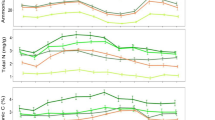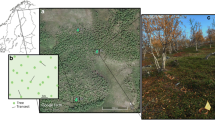Abstract
Natural environmental gradients provide important information about the ecological constraints on plant and microbial community structure. In a tropical peatland of Panama, we investigated community structure (forest canopy and soil bacteria) and microbial community function (soil enzyme activities and respiration) along an ecosystem development gradient that coincided with a natural P gradient. Highly structured plant and bacterial communities that correlated with gradients in phosphorus status and soil organic matter content characterized the peatland. A secondary gradient in soil porewater NH4 described significant variance in soil microbial respiration and β-1-4-glucosidase activity. Covariation of canopy and soil bacteria taxa contributed to a better understanding of ecological classifications for biotic communities with applicability for tropical peatland ecosystems of Central America. Moreover, plants and soils, linked primarily through increasing P deficiency, influenced strong patterning of plant and bacterial community structure related to the development of this tropical peatland ecosystem.








Similar content being viewed by others
References
Aerts R (1999) Interspecific competition in natural plant communities: mechanisms, trade-offs and plant-soil feedbacks. J Exp Bot 50:29–37
Aerts R, Verhoeven JTA, Whigham DF (1999) Plant-mediated controls on nutrient cycling in temperate fens and bogs. Ecology 80:2170–2181
Allison VJ, Condron LM, Peltzer DA, Richardson SJ, Turner BL (2007) Changes in enzyme activities and soil microbial community composition along C and nutrient gradients at the Franz Josef chronosequence, New Zealand. Soil Biol Biochem 39:1770–1781
Amador JA, Jones RD (1993) Nutrient limitations on microbial respiration in peat soils with different total phosphorus content. Soil Biol Biochem 25:793–801
Anderson JAR (1983) The tropical peat swamps of western Malesia. In: Gore AJP (ed) Ecosystems of the world: mires: swamp, bog, fen and moor. 4B, Regional Studies. Elsevier, New York, pp. 181–199
Badri DV, Vivanco JM (2009) Regulation and function of root exudates. Plant Cell Environ 32:666–681
Belyea LR, Baird AJ (2006) Beyond “the limits to peat bog growth”: cross-scale feedback in peatland development. Ecol Monogr 76:299–322
Bragazza L, Rydin H, Gerdol R (2005) Multiple gradients in mire vegetation: a comparison of a Swedish and an Italian bog. Plant Ecol 177:223–236
Bridgham SD, Richardson CJ (1993) Hydrology and nutrient gradients in North Carolina peatlands. Wetlands 13:207–218
Chimner RA (2004) Soil respiration rates of tropical peatlands in Micronesia and Hawaii. Wetlands 24:51–56
Chróst RJ, Krambeck HJ (1986) Fluorescence correction for measurements of enzyme activity in natural waters using methylumbelliferyl-substrates. Arch Hydrobiol 106:79–90
Clarkson BR, Louis AE, Schipper A, Moyersoen B, Silvester WB (2005) Foliar 15N natural abundance indicates phosphorus limitation of bog species. Oecologia 144:550–557
Condit R (1998) Tropical forest census plots: methods and results from Barro Colorado Island, Panama and a comparison with other plots. Springer-Verlag
Convention on Wetlands of International Importance especially as Waterfowl Habitat. Ramsar (Iran) (1971) UN Treaty Series No. 14583. As amended by the Paris Protocol, 3 December 1982, and Regina Amendments, 28 May 1987
D’Angelo EM, Reddy KR (1999) Regulators of heterotrophic microbial potentials in wetland soils. Soil Biol Biochem 31:815–830
DeLucia EH, Schlesinger WH (1995) Photosynthetic rates and nutrient-use efficiency among evergreen and deciduous shrubs in Okefenokee Swamp. Int J Plant Sci 156:19–28
Dimitriu PA, Grayston SJ (2010) Relationship between soil properties and patterns of bacterial β-diversity across reclaimed and natural boreal forest soils. Microb Ecol 59:563–573
Domaine R, Couwenberg J, Joosten H (2011) Development and carbon sequestration of tropical peat domes in south-east Asia: links to post-glacial sea-level changes and Holocene climate variability. Quaternary Sci Rev 30:999–1010
Ehrenfeld JG, Ravit B, Elgersma K (2005) Feedback in the plant-soil system. Annu Rev Environ Resour 30:75–115
Feller IC, McKee KL, Whigham DF, O’Neill JP (2002) Nitrogen vs. phosphorus limitation across an ecotonal gradient in a mangrove forest. Biogeochemistry 62:145–175
Fierer N, Bradford MA, Jackson RB (2007) Toward an ecological classification of soil bacteria. Ecology 88:1354–1364
Fierer N, Nemergut D, Knight R, Craine JM (2010) Changes through time: integrating microorganisms into the study of succession. Research in Microbiology 161:635–642
Fisk MC, Ruether KF, Yavitt JB (2003) Microbial activity and functional composition among northern peatland ecosystems. Soil Biol Biochem 35:591–602
Gorokhova E (2005) Effects of preservation and storage of microcrustaceans in RNA later on RNA and DNA degradation. Limnol Oceanogr Meth 3:143–148
Güsewell S, Gessner MO (2008) N:P ratios influence litter decomposition and colonization by fungi and bacteria in microcosms. Funct Ecol 23:211–219
Haase J, Brandl R, Scheu S, Schädler M (2008) Above- and belowground interactions are mediated by nutrient availability. Ecology 89:3072–3081
Hacker SD, Bertness MD (1999) Experimental evidence for factors maintaining plant species diversity in a New England salt marsh. Ecology 80:2064–2073
Harrison KA, Bol R, Bardgett RD (2007) Preferences for different nitrogen forms by coexisting plant species and soil microbes. Ecology 88:989–999
Hirano T, Jauhiainen J, Inoue T, Takahashi H (2009) Controls on the carbon balance of tropical peatlands. Ecosystems 12:873–887
Hooper DH, Bignell DE, Brown VK, Brussaard L, Dangerfield JM, Wall DH, Wardle DA, Coleman DC, Giller KE, Lavelle P, van der Putten WH, DeRuiter PC, Rusek J, Silver WH, Tiedje JM, Wolters V (2000) Interactions between aboveground and belowground biodiversity in terrestrial ecosystems: patterns, mechanisms, and feedbacks. Bioscience 50:1049–1061
Hoppe HG (1993) Use of fluorogenic model substrates for extracellular enzyme activity (EEA) measurement of bacteria. In: Kemp PF et al (eds) Handbook of methods in aquatic microbial ecology. Lewis Publishers, Boca Raton, pp 423–431
Ikenaga M, Guevara R, Dean AL, Pisani C, Boyer JN (2010) Changes in community structure of sediment bacteria along the Florida Coastal Everglades Marsh–Mangrove–Seagrass Salinity Gradient. Microb Ecol 59:284–295
Jackson CR, Liew KC, Yule CM (2009) Structural and functional changes with depth in microbial communities in a tropical Malaysian peat swamp forest. Microb Ecol 57:402–412
Kowalchuk GA, Buma D, de Boer W, Klinkhamer PGL, van Veen JA (2002) Effects of above-ground plant species composition and diversity on the diversity of soil-borne microorganisms. Anton van Leeuw 81:509–520
Kramer I, Holscher D (2010) Soil water dynamics along a tree diversity gradient in a deciduous forest in Central Germany. Ecohydrology 3:262–271
Langenheder S, Prosser JI (2008) Resource availability influences the diversity of a functional group of heterotrophic bacteria. Environ Microbiol 10:2245–2256
Liu Z, Fu B, Zheng X, Liu G (2010) Plant biomass, soil water content and soil N:P ratio regulating soil microbial functional diversity in a temperate steppe: a regional scale study. Soil Biol Biochem 42:445–450
Marilley L, Aragno M (1999) Phylogenetic diversity of bacterial communities differing in degree of proximity of Lolium perenne and Trifolium repens roots. Appl Soil Ecol 13:127–136
Meier CL, Bowman WD (2008) Links between plant litter chemistry, species diversity, and below-ground ecosystem function. Proc Natl Acad Sci 105:19780–19785
Mitsch WJ, Gosselink JG (2000) Wetlands, 3rd edn. Wiley, New York
Muyzer G, Smalla K (1998) Application of denaturing gradient gel electrophoresis (DGGE) and temperature gradient gel electrophoresis (TGGE) in microbial ecology. Anton van Leeuw 73:127–141
Nemergot DR, Cleveland CC, Wieder WR, Washenberger CL, Townsend AR (2010) Plot-scale manipulations of organic matter inputs to soils correlate with shifts in microbial community composition in a lowland tropical rain forest. Soil Biol Biochem 42:2153–2160
Olander LP, Vitousek PM (2000) Regulation of soil phosphatase and chitinase activity by N and P availability. Biogeochemistry 49:175–190
Page SE, Rieley JO, Shotyk OW, Weiss D (1999) Interdependence of peat and vegetation in a tropical peat swamp forest. Philos Trans R Soc Lond B 354:1885–1897
Parfitt RL, Ross DJ, Coomes DA, Richardson SJ, Smale MC, Dahlgren RA (2005) N and P in New Zealand soil chronosequences and relationships with foliar N and P. Biogeochemistry 75:305–328
Peltoniemi K, Fritze H, Laiho R (2009) Response of fungal and actinobacterial communities to water-level drawdown in boreal peatland sites. Soil Biol Biochem 41:1902–1914
Phillips S, Bustin R (1996) Sedimentology of the Changuinola peat deposit: organic and clastic sedimentary response to punctuated coastal subsidence. Geol Soc Am Bull 108:794–814
Phillips S, Rouse G, Bustin R (1997) Vegetation zones and diagnostic pollen profiles of a coastal peat swamp, Bocas del Toro, Panamá. Palaeogeogr Palaeocol Palynol 128:301–338
Philippot L, Tscherko D, Bru D, Kandeler E (2011) Distribution of high bacterial taxa across the chronosequence of two alpine glacier forelands. Microb Ecol 61:303–312
R Development Core Team (2008). R: a language and environment for statistical computing. R Foundation for Statistical Computing, Vienna, Austria. ISBN 3-900051-07-0, URL http://www.R-project.org
Richardson SJ, Peltzer DA, Allen RB, McGlone MS, Parfitt RL (2004) Rapid development of phosphorus limitation in temperate rainforest along the Franz Josef soil chronosequence. Oecologia 139:267–276
Rydin H, Jeglum J (2006) Chapter 7, Peatland succession and development. The Biology of Peatlands, Oxford University Press Inc, New York, USA, pp. 119–137
Sjogersten S, Cheesman AW, Lopez O, Turner BL (2011) Biogeochemical processes along a nutrient gradient in a tropical ombrotrophic peatland. Biogeochemistry 104:147–163
Solorzano L, Sharp J (1980) Determination of total dissolved P and particulate P in natural waters. Limnol Oceanogr 25:754–758
Tarnocai C, Stolbovoy V (2006) Northern peatlands: their characteristics, development and sensitivity. In: Martini IP, Martinez Conrtizas A, Chesworth W (eds) Peatlands: evolution and records of environmental and climate changes, Developments in Earth Surface Processes, 9. Elsevier, New York, pp. 181–199
Troxler TG (2007) Patterns of phosphorus, nitrogen and δ15N along a peat development gradient in a coastal mire, Panama. J Trop Ecol 23:683–691
Van der Heijden MGA, Bardgett RD, van Straalen NM (2008) The unseen majority: soil microbes as drivers of plant diversity and productivity in terrestrial ecosystems. Ecol Lett 11:296–310
Walbridge MR (1991) Phosphorus availability in acid organic soils of the lower North Carolina coastal plain. Ecology 72:2083–2100
Waldrop MA, Zak DR, Blackwood CB, Curtis CD, Tilman D (2006) Resource availability controls fungal diversity across a plant diversity gradient. Ecol Lett 9:1127–1135
Walker TW, Syers JK (1976) The fate of phosphorus during pedogenesis. Geoderma 15:1–19
Yavitt JB, Williams CJ, Wieder RK (1997) Production of methane and carbon dioxide in peatland ecosystems across North America: effects of temperature, aeration, and organic chemistry of peat. Geomicrobiol J 14:299–316
Yavitt JB, Williams CJ, Wieder RK (2005) Soil chemistry versus environmental controls on production of CH4 and CO2 in northern peatlands. Eur J Soil Sci 56:169–178
Acknowledgments
The authors would like to acknowledge B. Giraldo, G. Jacome, P. Gondola, E. Brown, M. Barry, D. Johnson and I. Mendoza for field, lab and logistical assistance. Drs. S. Davis, D. Liptzin and J. Edmonds provided helpful comments on earlier drafts of this manuscript. We are grateful to the Smithsonian Tropical Research Institute and R. Collins for assistance with travel funding through a fellowship to T. Troxler. This material is based upon work supported by the National Science Foundation through the Florida Coastal Everglades Long-Term Ecological Research program under Grants No. DBI-0620409 and No. DEB-9910514. This is contribution #548 of the Southeast Environmental Research Center at Florida International University.
Author information
Authors and Affiliations
Corresponding author
Electronic Supplementary Material
Below is the link to the electronic supplementary material.
Electronic Supplementary Materials
(DOC 36 kb)
Rights and permissions
About this article
Cite this article
Troxler, T.G., Ikenaga, M., Scinto, L. et al. Patterns of Soil Bacteria and Canopy Community Structure Related to Tropical Peatland Development. Wetlands 32, 769–782 (2012). https://doi.org/10.1007/s13157-012-0310-z
Received:
Accepted:
Published:
Issue Date:
DOI: https://doi.org/10.1007/s13157-012-0310-z




